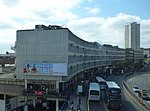Birmingham Back to Backs

The Birmingham Back to Backs (also known as Court 15) are the city's last surviving court of back-to-back houses. They are preserved as examples of the thousands of similar houses that were built around shared courtyards, for the rapidly increasing population of Britain's expanding industrial towns. They are a very particular sort of British terraced housing. This sort of housing was deemed unsatisfactory, and the passage of the Public Health Act 1875 meant that no more were built; instead byelaw terraced houses took their place. This court, at 50–54 Inge Street and 55–63 Hurst Street, is now operated as a historic house museum by the National Trust. Numerous back-to-back houses, two or three storeys high, were built in Birmingham during the 19th century. Most of these houses were concentrated in inner-city areas such as Ladywood, Handsworth, Aston, Small Heath and Highgate. Most were still in quite good condition in the early 20th century and also prior to their demolition. By the early 1970s, almost all of Birmingham's back-to-back houses had been demolished. The occupants were rehoused in new council houses and flats, some in redeveloped inner-city areas, while the majority moved to new housing estates such as Castle Vale and Chelmsley Wood.
Excerpt from the Wikipedia article Birmingham Back to Backs (License: CC BY-SA 3.0, Authors, Images).Birmingham Back to Backs
Inge Street, Birmingham Digbeth
Geographical coordinates (GPS) Address Website External links Nearby Places Show on map
Geographical coordinates (GPS)
| Latitude | Longitude |
|---|---|
| N 52.4743 ° | E -1.8972 ° |
Address
Inge Street 50;52;54
B5 4TE Birmingham, Digbeth
England, United Kingdom
Open on Google Maps








